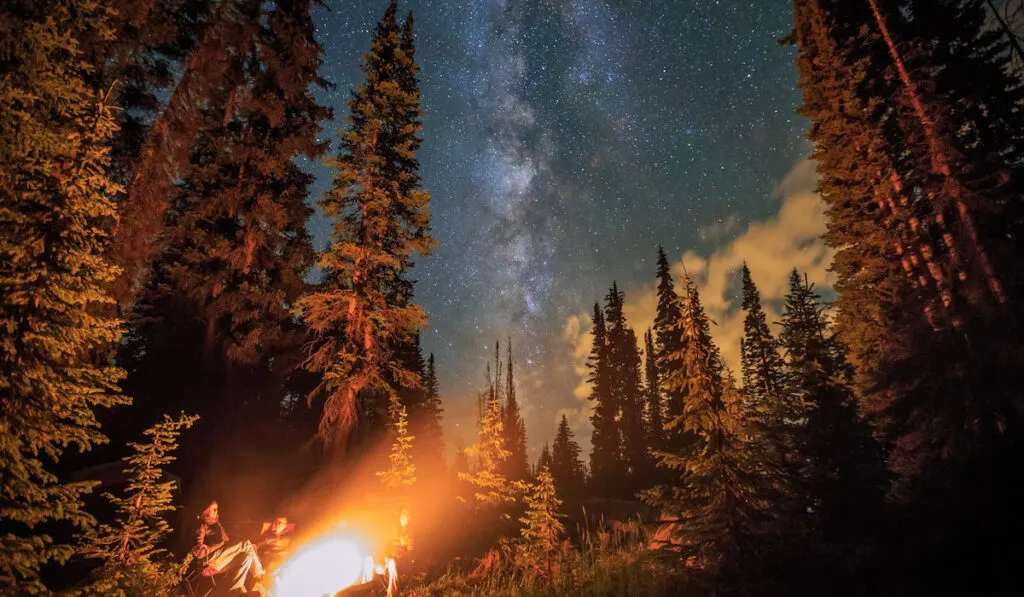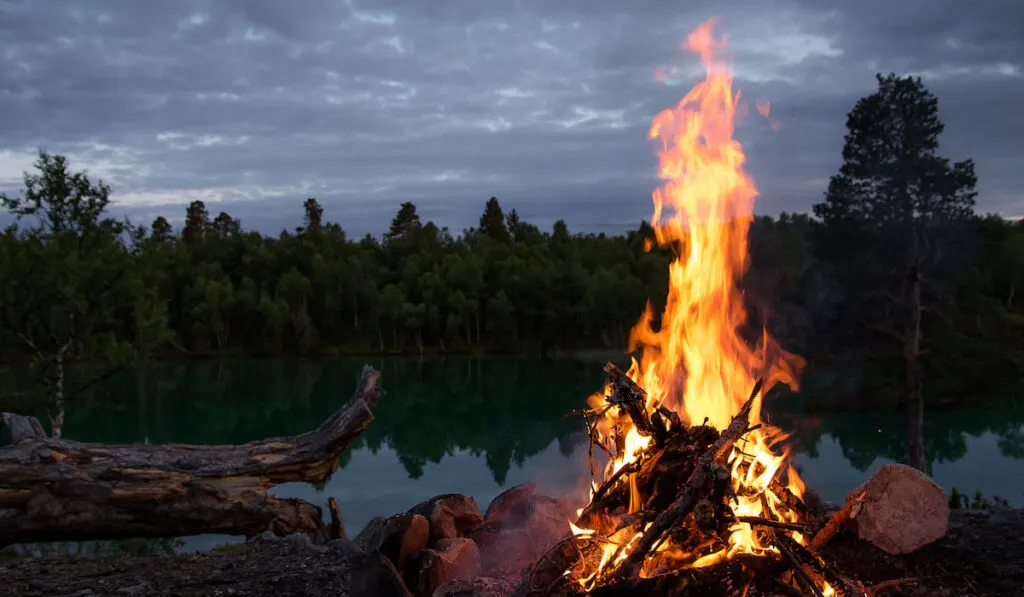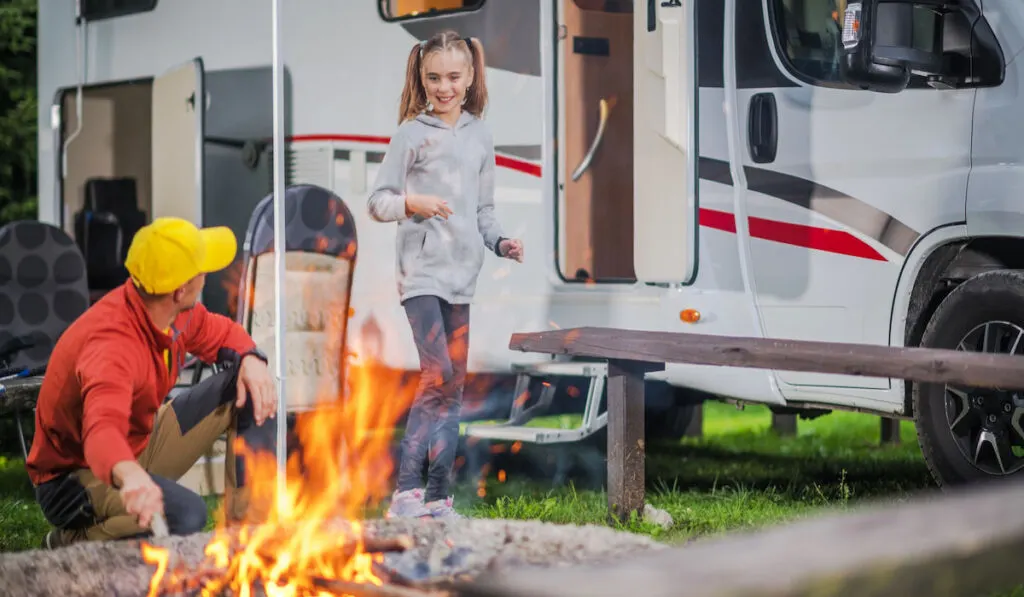Over the past couple of years, parks around the country have dealt with higher temperatures than average, which brings an increased risk of drought. Drier land makes fires more likely, so eliminating human fires helps avoid accidents and keeps forests and parks safer.
You may have noticed that some managed forested areas have fire restrictions above a certain altitude, specifically 5,000 feet.
Why no campfires above 5,000 feet?
National parks and many other areas ban any campfires above 5,000 feet because that’s generally where the tree line is. Above 5,000 feet, trees and other large plant life have a harder time surviving, so any runaway fires threaten their survival.
Of course, the tree line is not set in stone at 5,000 feet everywhere you go. Tree lines depend on other factors like temperature, soil quality, humidity, and more.
However, the 5,000-feet guideline is a general rule many places follow to make it easier for people to remember and manage fires responsibly.

It’s frustrating for some, for sure, to deal with fire restrictions.
People who grew up decades ago had fewer restrictions on where and when they could light campfires. It was part of growing up, and sitting around the campfire with friends and family on a campout or late weekend evening is always fun.
Knowing why the 5,000-feet campfire restriction is in place will help you understand the risks to plant life and why conservation efforts are so important. Let’s take a look at where the rule came from and why.

Table of Contents
What the Tree Line Means
The tree line is the area in which dense forests can survive.
If you go on a hike at higher elevations, you’ll eventually reach a point where trees become sparser. There is more space between trees, and they become smaller.
The trees that do exist grow much slower at high elevations as well. There are generally fewer nutrients in the soil at higher elevations, and the trees also provide biomass to areas that need it.
Trees at the tree line are much more susceptible to wind and cold. Often, you’ll see smaller trees with twisted limbs and fewer leaves due to weather conditions.
In some places, the tree line is clearly marked. In others, it’s a gradual decrease in tree density.

Why the Tree Line Matters
If you read through the section above, you can start making pretty intelligent guesses about why the tree line matters so much and why governments and park authorities are trying to protect it.
- Greater Destruction — Fires above the tree line threaten to quickly destroy decades or hundreds of years of growth. It takes a significant amount of time for even small trees and bushes to grow. A fire wipes them out in minutes.
- Harder Rescue Response — It’s harder for fire crews and first responders to get above the tree line. That means it typically takes longer to respond to fire calls, and it’s harder to put out fires when they get out of control.
- Less Firewood — When you’re above 5,000 feet, it’s harder to grab some fallen branches and scrounge for dead wood to start a fire. As a result, some people are tempted to grab wood off living trees or even cut smaller trees down. This does great harm to plant life higher up.
- Strong Winds — As you go up, the threat of strong winds increases. When there are fewer trees, the wind moves quickly across large areas. Strong winds can carry embers hundreds of feet in any direction if a fire starts and greatly increase the risks of unintended fires.
- Resource Deprivation — If campers and other visitors gather up all of the dead vegetation for campfires, it leaves little for plant life and soil regeneration. Plants will struggle for nutrients in a place where it’s already hard to find.
These are some of the main reasons parks instigate campfire bans at 5,000 feet.
While each location will vary in terms of fire risks, the common restriction makes it easier for campers and other visitors to remember where fires are appropriate and where they shouldn’t light fires at all.

Some Places Allow Campfires in Developed Campgrounds
In some areas, park authorities allow campfires above 5,000 feet in developed campgrounds where proper fire mitigation policies are in place.
In California, for example, developed campgrounds managed by California Land Management allow campfires at certain times, even when the 5,000-foot restriction is in place.
As a best practice, check with your campground before you arrive to see whether fires are allowed. It will save you some weight if you’re planning on buying firewood and bringing it to camp with you.
What Constitutes a Campfire?
The campfire restrictions generally don’t mean that no fire at all is allowed. Park authorities typically allow heating lamps, grills, and LPG stoves for cooking.
Campfires, in terms of the restrictions, usually mean an open wood-burning fire. So it doesn’t matter if it’s in a fire pit, surrounded by rocks, or you consider yourself a fire safety expert.
They’re trying to prevent open fires where people gather what they believe to be deadwood. Unfortunately, in many instances, people end up breaking living tree limbs off of trees and using them for firewood.
Depending on how easy it is to access your camping area, you can pack a stove to cook meals, make coffee, and use devices to keep warm when it gets too cold.

Protecting High Elevation Ecosystems
The ecosystem above the tree line is exceptionally fragile. With so few nutrients in the soil and less access to water, the trees, flowers, bushes, and grass all work together in a finely-tuned balance.
Plant life at high elevations takes years and years to grow, and the slightest change in conditions will impact survivability.
If a fire starts and is allowed to spread, it will possibly kill everything in a wide area. What’s more, the ash from the fire will affect the soil content and throw the ecosystem out of whack.
Check for Other Restrictions
In parks where restrictions are in place, the ban on campfires usually goes hand in hand with restrictions on other fire threats.
For example, Glacier National Park has placed bans on fireworks, sparklers, and other items people love to use during Fourth of July campouts.
Even though you remember how much fun it was as a kid to run around at night with a sparkler in your hand, the risk is simply not worth it in dry alpine environments.

Likewise, some places ban smoking above 5,000 feet, which is something to keep in mind for people who smoke cigarettes or cigars regularly.
If you want to see what is and isn’t allowed, check the park’s website or call the main office to ask what restrictions are in place. If you check ahead of time, it will help you pack appropriately or plan to be somewhere else if you want to have a fire.
Dry Conditions Mean More Restrictions
In general, expect restrictions on fires to increase whenever things are hot and dry. If you’re camping in an area lacking rain during the summer, then pay special attention to what types of fires, if any, are allowed.
Knowing the rules will help you avoid fines and other penalties and, more importantly, protect the trees and different plant life around you.
Final Thoughts
Keep the high-altitude ecosystem safe by practicing safe, responsible camping this summer. You can still have tons of fun wherever you are without lighting campfires in places they aren’t allowed.
